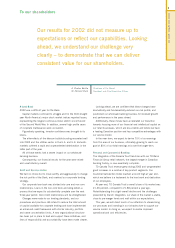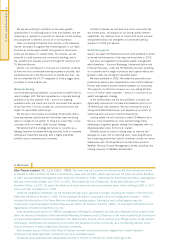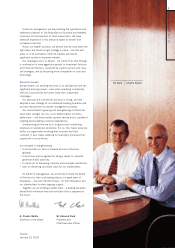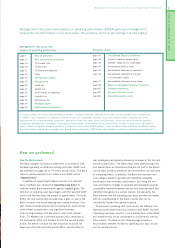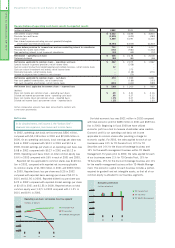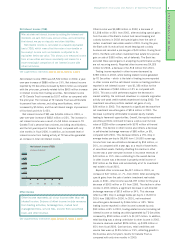TD Bank 2002 Annual Report Download - page 15
Download and view the complete annual report
Please find page 15 of the 2002 TD Bank annual report below. You can navigate through the pages in the report by either clicking on the pages listed below, or by using the keyword search tool below to find specific information within the annual report.
13
HOW WE PERFORMED IN 2002
SPEs only when the Bank retains substantially all the residual
risks and rewards of the SPE. In addition, if the SPE’s activities
are sufficiently restricted to meet certain accounting require-
ments, the SPE should not be consolidated by the Bank. Under
Canadian GAAP, all of the Bank-originated assets transferred to
SPEs meet the criteria for sale treatment and non-consolidation.
However, it should be noted that both the Canadian Accounting
Standards Board and the U.S. Financial Accounting Standards
Board have issued similar exposure drafts relating to the
consolidation of SPEs. See Note 23 to the Bank’s consolidated
financial statements for more details.
Valuation of goodwill and intangible assets
Under Canadian GAAP, goodwill is not amortized, but is instead
assessed for impairment at the reporting unit level on at least an
annual basis. Goodwill is assessed for potential impairment using
a two step approach with the first step being to assess whether
the fair value of the reporting unit to which the goodwill is
associated is less than its carrying value. When the fair value of
the reporting unit is less than the carrying value, a second
impairment test is performed. The second test requires a
comparison of the fair value of goodwill to its carrying amount. If
the fair value of goodwill is less than its carrying value, goodwill
is considered impaired and a charge for impairment must be
recognized immediately. The fair value of the Bank’s reporting
units are determined from internally and externally developed
valuation models. These models consider various factors such as
normalized and projected earnings, price earnings multiples and
discount rates. The Bank’s management uses judgement in
estimating the fair value of reporting units and imprecision in
estimates can affect the valuation of goodwill.
Intangible assets that derive their value from contractual
customer relationships or that can be separated and sold, and
have a finite useful life are amortized over their estimated useful
life. Determining the estimated useful life of these finite life
intangible assets requires an analysis of the circumstances and
judgement by the Bank’s management. Finite life intangible
assets are tested for impairment whenever circumstances
indicate that the carrying value may not be recoverable. See
Note 5 to the Bank’s consolidated financial statements for
more details.
Controls and procedures
An evaluation was performed under the supervision and with
participation of the Bank’s management, including the Chief
Executive Officer (CEO) and Chief Financial Officer (CFO), of the
effectiveness of the design and operation of the Bank’s disclosure
controls and procedures, as defined in the rules of the U.S.
Securities and Exchange Commission (SEC), within 90 days prior
to the filing of this annual report. Based on that evaluation, the
Bank’s management, including the CEO and CFO, concluded that
the Bank’s disclosure controls and procedures are effective. As
of the filing of the annual report, there have been no significant
changes in the Bank’s internal controls or in other factors that
could significantly affect the Bank’s internal controls subsequent
to the date of the evaluation.
Management’s Discussion and Analysis of Operating Performance
How our businesses performed
The Bank’s operations and activities are organized around
the following operating business segments: TD Canada Trust,
TD Securities and TD Wealth Management.
TD Canada Trust is a leader in personal and commercial
banking in Canada with about 10 million personal, small
business and commercial customers. TD Canada Trust provides a
full range of financial products and services to our personal
customers –anywhere, anytime –through the telephone, the
web, more than 2,600 automated banking machines, and our
network of 1,154 branches conveniently located across the
country offering the best banking hours in the business.
TD Canada Trust also provides lending, deposit, savings and
investment products to Canadian businesses, plus a full range
of day-to-day banking, cash management, trade and treasury
services.
TD Securities is a leading Canadian wholesale bank serving
corporate, government and institutional clients around the world.
TD Securities has developed a strong, diverse customer base
with its proven ability to meet client needs by combining its
knowledge and experience with a full range of capital markets
and investment banking products and services that include:
•advice on corporate strategy
•underwriting and distributing capital
•structuring tailored risk management solutions
•executing financial transactions.
TD Wealth Management is one of Canada's largest asset
managers, advisors and distributors of investment products, with
$112 billion in assets under management and $234 billion in
assets under administration. Also, TD Wealth Management
provides mutual funds, pooled funds, segregated account
management, full-service brokerage services and self-directed
investing to retail, mass affluent and private client segments. In
addition, investment management services are provided to
pension funds, corporations, institutions, endowments, and
foundations. TD Mutual Funds manages approximately $29
billion in 61 retail mutual funds and 30 managed portfolios for
Canadian investors. TD Waterhouse discount brokerage is a
world leader in self-directed investing, serving customers both
directly and through joint ventures in Canada, the United States,
the United Kingdom, Australia, India, Singapore, Hong Kong and
Luxembourg. In July 2002, TD Bank Financial Group launched a
new integrated approach to wealth management in Canada
bringing together Financial Planning, Discount Brokerage and
Investment Advice under the TD Waterhouse brand.
Results of each business segment reflect revenues, expenses,
assets and liabilities generated by the businesses in that
segment. The Bank utilizes the “cash basis” to measure and
evaluate the performance of each segment. Cash basis results
excludes non-cash charges related to goodwill and identified
intangible amortization from business combinations. For further
details see Note 18 on page 71 of the Bank’s consolidated
financial statements.


